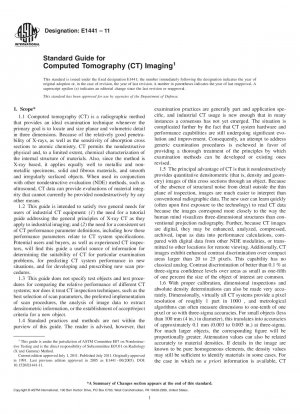ASTM E1441-11
Standard Guide for Computed Tomography (CT) Imaging
- Standard No.
- ASTM E1441-11
- Release Date
- 2011
- Published By
- American Society for Testing and Materials (ASTM)
- Status
- Replace By
- ASTM E1441-19
- Latest
- ASTM E1441-19
- Scope
This guide provides a tutorial introduction to the theory and use of computed tomography. This guide begins with a overview intended for the interested reader with a general technical background. Subsequent, more technical sections describe the physical and mathematical basis of CT technology, the hardware and software requirements of CT equipment, and the fundamental measures of CT performance. This guide includes an extensive glossary (with discussion) of CT terminology and an extensive list of references to more technical publications on the subject. Most importantly, this guide establishes consensus definitions for basic measures of CT performance, enabling purchasers and suppliers of CT systems and services to communicate unambiguously with reference to a recognized standard. This guide also provides a few carefully selected equations relating measures of CT performance to key system parameters.
General Description of Computed Tomography8212;CT is a radiographic inspection method that uses a computer to reconstruct an image of a cross-sectional plane (slice) through an object. The resulting cross-sectional image is a quantitative map of the linear X-ray attenuation coefficient, μ, at each point in the plane. The linear attenuation coefficient characterizes the local instantaneous rate at which X-rays are removed during the scan, by scatter or absorption, from the incident radiation as it propagates through the object (See 7.5). The attenuation of the X-rays as they interact with matter is a well-studied problem (1) and is the result of several different interaction mechanisms. For industrial CT systems with peak X-ray energy below a few MeV, all but a few minor effects can be accounted for in terms of the sum of just two interactions: photoelectric absorption and Compton scattering (1). The photoelectric interaction is strongly dependent on the atomic number and density of the absorbing medium; the Compton scattering is predominantly a function of the electron density of the material. Photoelectric attenuation dominates at lower energies and becomes more important with higher atomic number, while Compton scattering dominates at higher energies and becomes more important at lower atomic number. In special situations, these dependencies can be used to advantage (see 7.6.2 and references therein).
One particularly important property of the total linear attenuation coefficient is that it is proportional to material density, which is of course a fundamental physical property of all matter. The fact that CT images are proportional to density is perhaps the principal virtue of the technology and the reason that image data are often thought of as representing the distribution of material density within the object being inspected. This is a dangerous oversimplification, however. The linear attenuation coefficient also carries an energy dependence that is a function of material composition. This feature of the attenuation coefficient may or may not (depending on the materials and the energies of the X-rays involved) be more important than the basic density dependence. In some instances, this effect can be detrimental, masking the density differences in a CT image; in other instances, it can be used to advantage, enhancing the contrast between different materials of similar density.
The fundamental difference between CT and conventional radiography is shown in Fig. 1. In conventional radiography, information on the slice plane “P” projects into a single line, “A-A;” whereas with the associated CT image, the full spatial information is preserved. CT information is derived from a large numbe............
ASTM E1441-11 Referenced Document
- ASTM E1316 Standard Terminology for Nondestructive Examinations
- ASTM E1570 Standard Practice for Computed Tomographic (CT) Examination*, 2024-04-19 Update
ASTM E1441-11 history
- 2019 ASTM E1441-19 Standard Guide for Computed Tomography (CT)
- 2011 ASTM E1441-11 Standard Guide for Computed Tomography (CT) Imaging
- 2000 ASTM E1441-00(2005) Standard Guide for Computed Tomography (CT) Imaging
- 2000 ASTM E1441-00 Standard Guide for Computed Tomography (CT) Imaging
